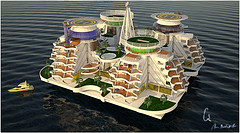The idea of Seasteading is discussed in detail in:
Seasteading: A Practical Guide to Homesteading the High Seas, by Patri Friedman, Wayne Gramlich, and Andrew House (Work in Progress, 2002-2008).

The book's abstract notes:
"A seastead is a structure designed specifically for permanent living on the ocean’s surface. There are many aspects to designing such structures, including motivation, engineering, infrastructure, and project planning. The primary motivations for living on these structures are a desire for political and/or religious freedom, a more environmentally sound way of life, and the sheer adventure of it all. A seastead must be able to withstand strong waves, winds, and currents. We describe previous attempts at ocean occupation and several possible designs. Our top choice is based on a hollow vertical tube, called a spar. A ballasted flotation hull is attached at the bottom and a living platform is attached at the top. The spar keeps the hull well below the waves and the platform well above them. The residents will also require food, water, and energy. Energy comes from a combination of solar, wind, wave, and diesel generators, water comes from collected rainwater, solar distillation, and reverse osmosis, and food from hydroponics and high density “victory gardens.” We advocate an incremental development model based on niche markets and prototypes, rather than a single large and financially risky project."